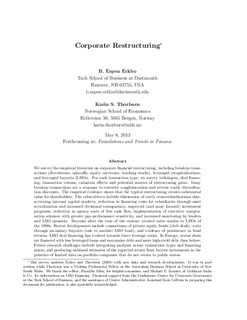Corporate restructuring
Working paper
Permanent lenke
http://hdl.handle.net/11250/170375Utgivelsesdato
2013Metadata
Vis full innførselSamlinger
- Working papers (FIN) [10]
Sammendrag
We survey the empirical literature on corporate nancial restructuring, including breakup transactions
(divestitures, spin-o s, equity carveouts, tracking stocks), leveraged recapitalizations,
and leveraged buyouts (LBOs). For each transaction type, we survey techniques, deal nancing,
transaction volume, valuation e ects and potential sources of restructuring gains. Many
breakup transactions are a response to excessive conglomeration and reverse costly diversi cation
discounts. The empirical evidence shows that the typical restructuring creates substantial
value for shareholders. The value-drivers include elimination of costly cross-subsidizations characterizing
internal capital markets, reduction in nancing costs for subsidiaries through asset
securitization and increased divisional transparency, improved (and more focused) investment
programs, reduction in agency costs of free cash
ow, implementation of executive compensation
schemes with greater pay-performance sensitivity, and increased monitoring by lenders
and LBO sponsors. Buyouts after the turn of the century created value similar to LBOs of
the 1980s. Recent developments include consortiums of private equity funds (club deals), exits
through secondary buyouts (sale to another LBO fund), and evidence of persistence in fund
returns. LBO deal nancing has evolved towards lower leverage ratios. In Europe, recent deals
are nanced with less leveraged loans and mezzanine debt and more high-yield debt than before.
Future research challenges include integrating analyses across transaction types and nancing
mixes, and producing unbiased estimates of the expected return from buyout investments in the
presence of limited data on portfolio companies that do not return to public status.
